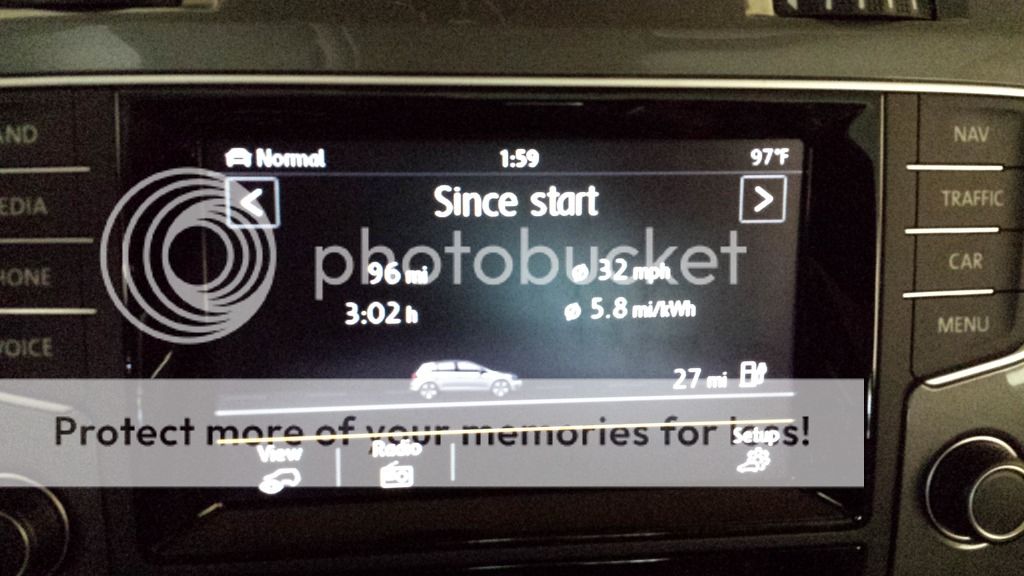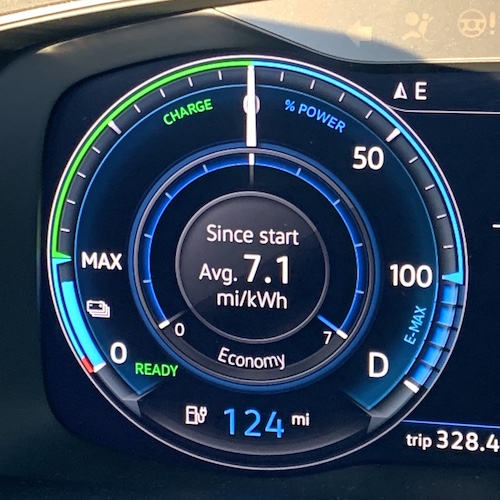I don't know if this is normal or if I have something wrong with my car but the range on this thing is completely erratic and unreliable. And so I can never trust it, which makes me nervous to drive the car very far. This weekend I drove 22 miles away and recorded my range at different points of the drive. I charged to 80% with the e-planner before leaving and had 118 miles of range. This is what happened.
At 12 miles I added 16 miles to my range, up to 134. HOW?!?
At the 22 mile destination I had exactly the same number of miles I started with.
On the return trip I again started with 118 miles of range and things got crazy!
At 4 miles I lost 20 miles of range.
At 6 miles I lost 25 miles of range.
At 9 miles I lost 30 miles of range.
At 12 miles I lost 35 miles of range.
At 14 miles I lost 40 miles of range.
At 15 miles I lost 45 miles of range.
At 17 miles I lost 50 miles of range.
At 18 miles I lost 55 miles of range.
At 19 miles I lost 60 miles of range.
At 21 miles I lost 65 miles of range.
At 22 miles I think it was still 65 miles lost.
HOW did I go from 118 miles to 134 miles of range after driving the first 12 miles?!?!? This is more than 100% battery range but it still showed 80% on the meter. I was so surprised I took a photo of the instrument panel and got a screenshot of Car-net app showing 134 miles of range at 80% charge. At 22 miles I returned to where I started with 118 miles of range. Again, weird! Then I lost 65 miles on the final 22 mile return drive. So I lost a total 65 miles of range in just 44 miles and I had 53 miles of range left upon my return.
The problem is at no time did I ever have an accurate reading of my true range. So how can I ever count on the reported range???
I think something was way off when it said I had 118 miles with 80% charge to start and even worse when it said 134 miles of range at 80% after 12 miles. I thought 118 was too high and expected it to drop rapidly instead of increase.
If we assume 53 miles at the end is the correct, then the starting range should have said 97, which would have made sense for 80% charge. And then it should have steadily dropped to 53 instead of wildly fluctuating.
What I experienced on this trip is not unusual, I am often getting range changes that feel random and never reflect the distance I've traveled. It is beyond frustrating. My car is less than two weeks old with just about 300 miles on it so still very new. Is this eventually going to stabilize? Or is this normal for this car? Or do I have a problem that needs to get checked out?
HELP!
At 12 miles I added 16 miles to my range, up to 134. HOW?!?
At the 22 mile destination I had exactly the same number of miles I started with.
On the return trip I again started with 118 miles of range and things got crazy!
At 4 miles I lost 20 miles of range.
At 6 miles I lost 25 miles of range.
At 9 miles I lost 30 miles of range.
At 12 miles I lost 35 miles of range.
At 14 miles I lost 40 miles of range.
At 15 miles I lost 45 miles of range.
At 17 miles I lost 50 miles of range.
At 18 miles I lost 55 miles of range.
At 19 miles I lost 60 miles of range.
At 21 miles I lost 65 miles of range.
At 22 miles I think it was still 65 miles lost.
HOW did I go from 118 miles to 134 miles of range after driving the first 12 miles?!?!? This is more than 100% battery range but it still showed 80% on the meter. I was so surprised I took a photo of the instrument panel and got a screenshot of Car-net app showing 134 miles of range at 80% charge. At 22 miles I returned to where I started with 118 miles of range. Again, weird! Then I lost 65 miles on the final 22 mile return drive. So I lost a total 65 miles of range in just 44 miles and I had 53 miles of range left upon my return.
The problem is at no time did I ever have an accurate reading of my true range. So how can I ever count on the reported range???
I think something was way off when it said I had 118 miles with 80% charge to start and even worse when it said 134 miles of range at 80% after 12 miles. I thought 118 was too high and expected it to drop rapidly instead of increase.
If we assume 53 miles at the end is the correct, then the starting range should have said 97, which would have made sense for 80% charge. And then it should have steadily dropped to 53 instead of wildly fluctuating.
What I experienced on this trip is not unusual, I am often getting range changes that feel random and never reflect the distance I've traveled. It is beyond frustrating. My car is less than two weeks old with just about 300 miles on it so still very new. Is this eventually going to stabilize? Or is this normal for this car? Or do I have a problem that needs to get checked out?
HELP!



































